
St. Marys Historic District is a national historic district located at St. Marys in Elk County, Pennsylvania. It includes 399 contributing buildings, two contributing sites, one contributing structure, and five contributing objects. It encompasses the historic central business district, adjacent residential district, and St. Joseph's Convent. Also located in the district are several historic churches. The oldest building in the district is a stone structure built about 1845. The earliest section is oriented around the "Diamond." Located within the district is the separately listed John E. Weidenboerner House. Also located in the district are two buildings designed by architect William P. Ginther; the Sacred Heart Church (1906-1907) and the addition to St. Joseph's Convent (1907).

The Nazareth Historic District is a national historic district located in the center of the Borough of Nazareth, Northampton County, Pennsylvania, which is located ten miles northeast of Bethlehem and seven miles northwest of Easton.

Roaring Spring Historic District is a national historic district located at Roaring Spring, Blair County, Pennsylvania. The district includes 573 contributing buildings, 3 contributing sites, and 2 contributing structures in the central business district and surrounding residential areas of Roaring Spring. The earliest buildings date to the 1860s, when the community was founded as the region's first paper mill town. The buildings are primarily frame and brick, with notable examples of Colonial Revival and Queen Anne style architecture. Notable non-residential buildings include the Odd Fellows Hall (1882), Hite's Furniture Store, Roaring Spring Bank (1902), old Borough Building and Fire Station (1906), Zook Building, Bare Memorial Church of God (1889-1930), Trinity United Methodist Church (1898), Blank Book Company buildings, and Roaring Spring Passenger Station. Also located in the district are the Bare Memorial Fountain (1937) and Greenlawn Cemetery and Memorial Park.

Williamsburg Historic District is a national historic district located at Williamsburg, Blair County, Pennsylvania. The district includes 362 contributing buildings and 6 contributing structures in the central business district and surrounding residential areas of Williamsburg. The earliest buildings date to the 1830s, when the community was expanded as a canal town along the Pennsylvania Main Line Canal. The buildings are primarily frame and brick, with notable examples of Federal and Late Victorian style architecture. Notable non-residential buildings include the Schwab Hotel, Hollidaysburg Trust Company (1873), Presbyterian Church (1841), Zion Lutheran Church (1907), Church of the Brethren (1911), Williamsburg High School (1918), and Community Elementary School (1941). Also located in the district are Presbyterian, Methodist, Lutheran, and Lutheran and German Reformed cemeteries; Big Spring; and the Pennsylvania Main Line Canal and Pennsylvania Railroad right-of-way.
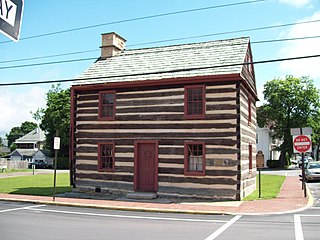
Philipsburg Historic District is a national historic district located at Philipsburg, Centre County, Pennsylvania. The district includes 228 contributing buildings and 2 contributing sites in the central business district and surrounding residential areas of Philipsburg. The oldest house is the John Henry Simler House (1807). Notable non-residential buildings include the Town Hall (1887), U.S. Post Office (1935), Union Church (1820-1840), St. Paul's Episcopal Church (1911), First Presbyterian Church (1908), and New Life Center Church (1893). The contributing sites are two small parks at the center of Philipsburg. Also located in the district are the separately listed Hardman Philips House, Rowland Theater, and Union Church and Burial Ground.
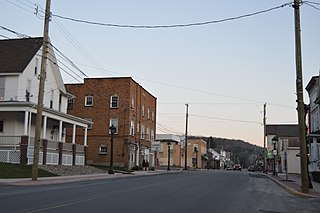
Coalport Historic District is a national historic district located at Coalport, Clearfield County, Pennsylvania. The district includes 41 contributing buildings in Coalport. The district is a mix of commercial and residential building, with half built between 1860 and 1890. Notable buildings include the United Methodist Church (1902), L.C. Hegarty and Son Used Cars (1941), Scott Hardware (1880), Bell's Drug Store (1884), Coalport 5&10 (1920), First National Bank (1922), Dixie Theater (1920), Central Hotel (1890), Hugh McNulty Hardware (1875), and V. Stevens Furniture Company (1875).
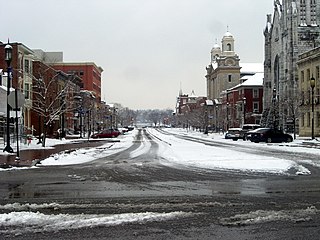
The Harrisburg Historic District is a national historic district which is located in Harrisburg, Dauphin County, Pennsylvania.

Mount Union Historic District is a national historic district located at Mount Union in Huntingdon County, Pennsylvania. The district includes 58 contributing buildings, 3 contributing sites, and 1 contributing structure in the central business district and surrounding residential areas of Mount Union. Notable buildings include the Federal-style John Shaver House (1818), Shapiro Theater (1915), T.A. Appleby Store and House, Kenmar Hotel, Penn Central National Bank (1916), Peduzzi's and the Weller Building (1913-1914), Pennsylvania Railroad Freight Depot (1914), St. Luke's Evangelical Lutheran Church (1904-1905), First United Methodist Church (1925-1926), St. Catherine of Siena Roman Catholic Church (1912-1913), Mount Union Elementary School (1923-1924), and U.S. Post Office (1936). The contributing sites include the I.O.O.F. community cemetery, founded in 1872, and the former Victoria Park. Located in the district and listed separately is the Harbison-Walker Refractories Company complex.

Downtown Indiana Historic District is a national historic district located at Indiana in Indiana County, Pennsylvania. The district includes 86 contributing buildings and 1 contributing site in the central business district and surrounding residential areas of Indiana. The district includes notable examples of buildings in the Italianate, Second Empire, and Queen Anne styles. Notable buildings include the Federal-style William Houston House, Clawson Hotel, Thomas Sutton House, Calvary Presbyterian Church, Zion Lutheran Church, First United Presbyterian Church, and First Methodist Episcopal Church. The contributing site is Memorial Park, established as a burial ground in the early 19th century. Located in the district and listed separately are the Silas M. Clark House, James Mitchell House, Old Indiana County Courthouse, Indiana Borough 1912 Municipal Building, Indiana Armory, and Old Indiana County Jail and Sheriff's Office.
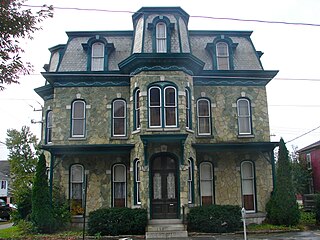
Danville Historic District is a national historic district located in Danville, Montour County, Pennsylvania. It encompasses 291 contributing buildings, 3 contributing sites, and 1 contributing object in the central business district and surrounding residential areas of Danville. The buildings mostly date from the 1840s to the early 20th century. The district incorporates the previously listed and predominantly residential Danville West Market Street Historic District. Residential buildings are mostly of brick and frame construction, with some log and stone dwellings, and in a variety of architectural styles including Italianate, Federal, Queen Anne and Second Empire. It includes the separately listed General William Montgomery House and Thomas Beaver Free Library and Danville YMCA. Other notable non-residential buildings include the Montour County Courthouse (1871), Mahoning Presbyterian Church (1853), Pine Street Lutheran Church, Eli Trego Building, Heim Suspender Factory (1835), First Ward School, Bnai Zion Temple, and Jemima Donaldson's Cross Keys Tavern.

Tamaqua Historic District is a national historic district located at Schuylkill Township and Tamaqua, Schuylkill County, Pennsylvania. The district includes 944 contributing buildings, 3 contributing sites, 8 contributing structures, and 3 contributing objects in the central business district and surrounding residential areas of Tamaqua. The residential buildings principally date to the early 20th century. They are mostly two-story, of brick and frame construction, and in a variety of popular architectural styles including Queen Anne, Late Victorian, Italianate, and Colonial Revival. Notable non-residential buildings include the Little Schuylkill Hotel (1827), White Swan, Washington House, Shepp Building, Elks Lodge, Peoples Trust Company Building, Tamaqua National Bank (1908), First National Bank of Tamaqua, U.S. Post Office (1932), Majestic Theater and Hotel, Hegarty Blacksmith Shop (1848), Conrad Biscoff Planing Mill and Furniture Factory (1865), Tamaqua Manufacturing Company (1910), Calvary Episcopal Church (1851), First Methodist Church (1852), St. Jerome's Roman Catholic Church (1856), American Hose Company (1881), East End Fire Co. (1923), and the former Tamaqua Armory. The contributing sites are St. Jerome's Cemetery, Odd Fellows Cemetery (1865), and the foundation of the Fitzpatrick Shirt Factory (1888). Contributing structures include three runs of iron steps and five bridges. Located in the district and separately listed are the Anthracite Bank Building, George Ormrod House, and Tamaqua Railroad Station.

The Lewisburg Historic District is a national historic district that is located in Lewisburg, Union County, Pennsylvania.

Union City Historic District is a national historic district located at Union City, Erie County, Pennsylvania. It includes 96 contributing buildings and 1 contributing structure in the central business district and surrounding residential areas of Union City. The district includes commercial, residential, and industrial buildings. The buildings were built between 1865 and 1925 and are in a variety of popular architectural styles including Late Victorian and Colonial Revival. The commercial buildings are mostly brick two- and three-story buildings. Notable buildings include the Hansen Building (1888), Clement Lodge Building (1890), I.O.O.F. Building (1889), Union City Chair Company, Mulkie House, Westcott House, and First Baptist Church (1923).

Waterford Borough Historic District is a national historic district located at Waterford, Erie County, Pennsylvania. It includes 41 contributing buildings in the central business district and surrounding residential areas of Waterford. The district includes commercial and residential buildings built between 1820 and 1939. They are in a variety of popular architectural styles including Greek Revival, Federal, and Italianate. The district includes the town square. Notable buildings include the St. Peter's Episcopal Church (1832), Presbyterian Church, Amos Judson House, and Judson's Store (1820). The district includes the separately listed Eagle Hotel (1826).
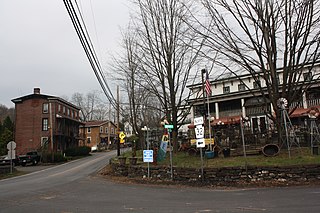
Point Pleasant Historic District is a national historic district located in Point Pleasant, Plumstead Township and Tinicum Township, Bucks County, Pennsylvania. The district includes 74 contributing buildings and 4 contributing structures in the riverfront and resort village of Point Pleasant. They include a variety of residential, commercial, and institutional buildings. The buildings are predominantly 2 1/2-story, stone and frame, gable roofed structures reflective of vernacular Greek Revival, Italianate, and Bungalow/craftsman styles. Notable buildings include "The Brambles," Thomas Schwartz House, Stover Mansion, Point Pleasant School (1850), Baptist Church (1852), Point Pleasant Hotel, Jacob Sutters Hotel, Waterman's Inn (1832), and the Stover Grist and Saw Mill. The contributing structures are four bridges that cross the Pennsylvania Canal.
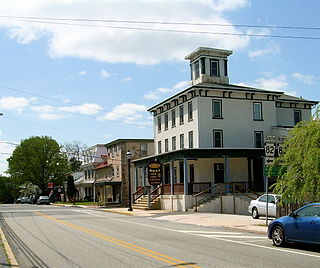
Elverson Historic District is a national historic district located in Elverson, Chester County, Pennsylvania. The district includes 133 contributing buildings, 3 contributing sites, and 4 contributing structures in the central business district and surrounding residential areas of Elverson. The district includes a variety of residential, commercial, and institutional buildings with examples of Bungalow/craftsman, Georgian, and Gothic Revival architecture. Contributing buildings date from about 1750 to about 1930. Notable buildings include "The Bank House", train station (1870), Springfield M.E. Church (1869), Blue Rock Hotel (1860), Dengler Bro. Store, Whoye Horse Tavern (1811), The Creamery (1906), and Springfield School (1873). One of the contributing structures is the railroad car "Baltimore County."

Oxford Historic District is a national historic district located in Oxford, Chester County, Pennsylvania. It encompasses 517 contributing buildings, 1 contributing sites, and 1 contributing structure in the central business district and surrounding residential areas of Oxford. They are mostly brick residential and commercial structures built between 1870 and 1910 and in a variety of popular architectural styles including Queen Anne and Italianate. Notable non-residential buildings include the Oxford Hall, Octoraro Hotel, Oxford Station, Dickey Building, Masonic Building, Fulton Bank Building (1925), Gibson's Store, Orthodox Friends Meeting House, Methodist Church (1885), United Presbyterian Church (1893), and the Oxford Grain & Hay Company granary (1880). The Oxford Hotel is located in the district and listed separately.

The McConnellsburg Historic District is a national historic district that is located in McConnellsburg, Fulton County, Pennsylvania.

The Montrose Historic District is a national historic district located in Montrose, Susquehanna County, Pennsylvania. The district encompasses 386 contributing buildings and two contributing sites in the central business district and surrounding residential areas of Montrose.

Marion Historic District is a national historic district located at Marion, Smyth County, Virginia. The district includes 361 contributing buildings, 2 contributing sites, and 1 contributing object in the central business district and surrounding residential areas of Marion. It includes a variety of residential, commercial, institutional, industrial, and governmental buildings primarily dating from the mid-19th to mid-20th centuries. Notable buildings include the Sheffey Loom House, Odd Fellows Lodge, Look & Lincoln Wagon Factory warehouse, the Beaux-Arts style Marion County Courthouse (1905), Mt. Pleasant Methodist Church, Courtview Building (1890s), Marion High School (1907-1908), Marion Junior College (1912), the Overall Factory, Weiler Building, Bank of Marion (1922), Royal Oak Presbyterian Church (1923), Marion Municipal Building (1935), Marion Post Office (1936), and a Lustron house (1948). Also located in the district are the separately listed Hotel Lincoln, Lincoln Theatre, Marion Male Academy, and Norfolk & Western Railway Depot.
























